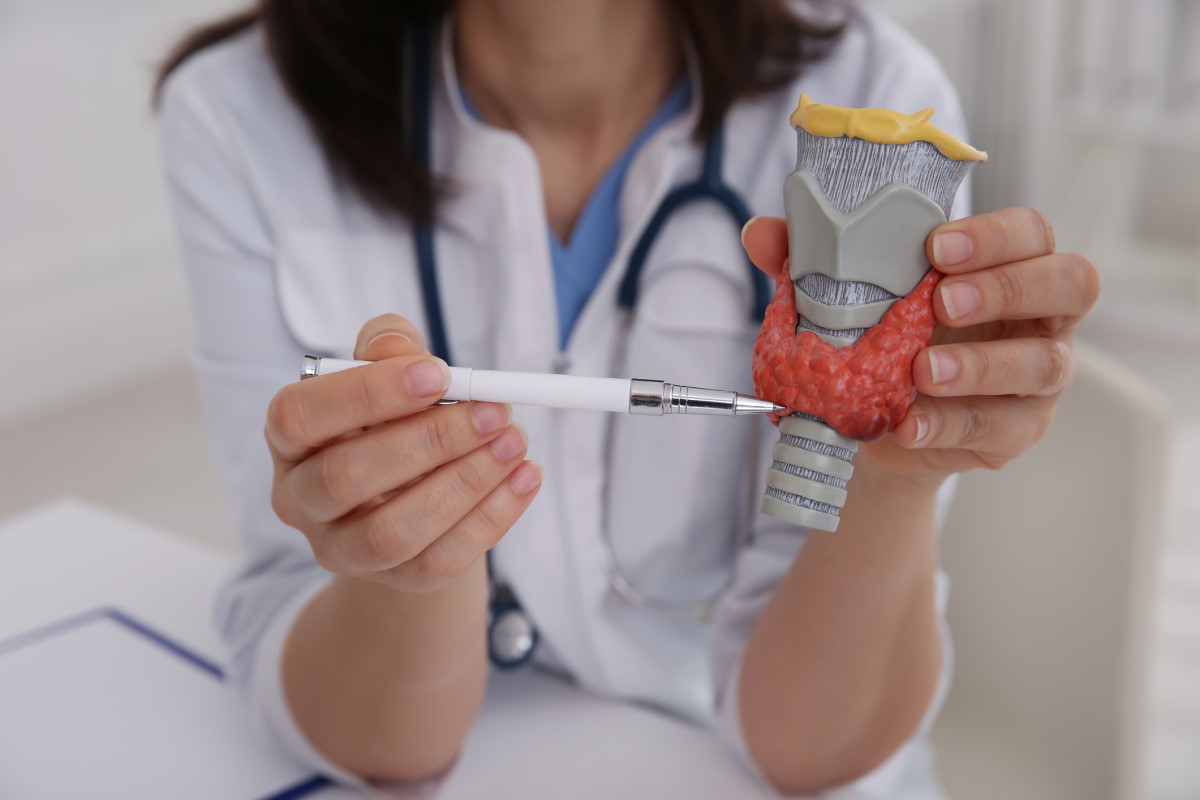- zona.fmed.uniba.sk - CURRENT PERSPECTIVES OF DIAGNOSTICS DIAGNOSTICS DIAGNOSTICS DIAGNOSTICS DIAGNOSTICS DIAGNOSTICS DIAGNOSTICS DIAGNOSTICS DIAGNOSTICS DIAGNOSTICS
- solen.cz - DIAGNOSIS AND THERAPY OF GALLERY DISORDERS - PART I
- mayoclinic.org - Hypothyroidism
- ncbi.nlm.nih.gov - Hypothyroidism
- mayoclinic.org - Hashimoto's disease
- detskanemocnica.sk - Newborn screening
- lekarsky.herba.sk - Subclinical hypothyroidism
Hypothyroidism: causes, symptoms and untreated thyroid disease

Hypothyroidism is a condition of reduced thyroid function. In it, the thyroid gland does not produce enough of its hormones, which are thyroxine and triiodothyronine.
Most common symptoms
- Muscle Pain
- Malaise
- Thickening of the voice
- Abdominal Pain
- Joint Pain
- Hoarseness
- Spirituality
- Constipation
- Depression - depressed mood
- Brittle nails - onychoschizia
- Brittle hair
- Gaining weight
- Muscle stiffness
- Excessive Hair Loss: Causes, Treatment
- Swelling of the limbs
- The Island
- Swollen eyelid
- Slow nail growth
- Erectile dysfunction
- Menstrual cycle disorders
- Memory disorders
- Slowed heartbeat
- Dry skin
- Muscle weakness
- Fatigue
- High blood pressure
- Heart enlargement
Characteristics
There may be no symptoms in the early stages of the disease, but untreated hypothyroidism can have serious, life-threatening complications.
The treatment of hypothyroidism is relatively simple and in most cases has no side effects. It involves taking the synthetic thyroid hormone levothyroxine.
The thyroid gland is an endocrine gland that is located on the neck at its base. It is found under the thyroid cartilage, which is particularly prominent in men and is called the coccyx.
The thyroid gland has lobes that resemble the shape of a butterfly. It is an endocrine gland and therefore produces hormones.
The thyroid gland has two types of cells, namely follicular and parafollicular.
Follicular cells produce the main thyroid hormones - triiodothyronine and thyroxine. These hormones also influence the control of vital functions such as body temperature and heart rate.
Parafollicular cells produce calcitonin, a hormone that regulates the metabolism and levels of calcium in the blood.
The thyroid gland is regulated by the pituitary gland and hypothalamus by a hormone called thyroglobulin (TSH). This hormone is produced in the hypothalamus and stored in the adenohypophysis.
Following its secretion, the thyroid gland is stimulated to function and produce its own hormones.

The main product of the thyroid gland is thyroxine. This hormone is only a precursor for the production of triiodothyronine. These hormones bind to the proteins of the blood plasma. Only the free fractions, abbreviated as fT3 and fT4, enter the cells.
Thyroid hormones have many important roles in the body. Their effects affect the fetus in utero and especially in the development of the brain, spinal cord and skeleton.
Other effects of thyroid hormones are:
- they maintain heart rate and heart rate
- maintain proper lung function and breathing
- promote bowel movements
- have a positive effect on the production of red blood cells
- they also affect other hormones, e.g. growth hormone, sex hormones, adrenal hormones
- accelerate the metabolism of sugars and fats
- stimulate bone turnover
- maintain proper skeletal muscle function
Hypothyroidism is a condition in which the thyroid gland does not produce enough of the necessary hormones.
Read also.
Causes
Among the most common are:
- autoimmune diseases, e.g. diffuse autoimmune thyroiditis
- radioiodine treatment
- treatment of hyperthyroidism - thyrostatics
- radiotherapy in the neck area
- previous thyroid surgery
- secondary hypothyroidism
- congenital ectropion or agenesis, i.e. underdevelopment of the gland
- infection with certain pathogens, e.g. Pneumocystis carini
- Kaposi's sarcoma in patients with AIDS
- drugs containing iodine (amiodarone), interferon alfa, cytostatics
- iodine contrast agents
- lithium
- amyloidosis
- haemochromatosis
- cystinosis
Autoimmune diseases
Autoimmune disease is the most common cause of reduced thyroid function - hypothyroidism. This disease is called Hashimoto's thyroiditis.
In this disease, the body's own immune system produces antibodies. These attack the thyroid tissue as if they were foreign pathogens, such as bacteria or viruses. The thyroid cells are irreversibly damaged by the autoimmune inflammation and die.
The disease can be caused by a variety of causes, e.g. hereditary, genetic, predisposing factors, environmental factors such as infectious disease, excessive stress or exposure to radioactive radiation.
Excessive response to treatment of hyperthyroidism
Patients with overactive thyroid function (hyperthyroidism) are treated with radioactive iodine or thyroid-influencing drugs called thyreostatics. The goal of this type of treatment is to return the thyroid gland to its normal function.
Sometimes, however, patients react in the opposite way by having too much reduced thyroid function. They go from hyperthyroidism to the opposite state - hypothyroidism.
Thyroid surgery
Another therapeutic intervention for hyperthyroidism is to remove all or part of the thyroid gland. This intervention can also reduce or even stop the production of thyroid hormones.
External radiotherapy
This is the therapeutic application of radioactive radiation for head and neck tumours. However, this radiation directly hits the thyroid cells and stops the production of hormones.
Medicines
There are medications that are used to treat diseases other than thyroid disease. Their side effect is to reduce thyroid function.
Examples of such drugs are amiodarone, which is used to treat heart rhythm disorders, lithium, which is used to treat some psychiatric disorders, or interferon-beta, which is used for autoimmune diseases such as multiple sclerosis.
Congenital developmental defects
Some babies are born with a congenital developmental defect, where the thyroid gland is not developed at all (agenesis), not developed enough (aplasia), or there has been an error in its development and it is not functioning properly.
Babies with congenital hypothyroidism may look completely normal and healthy at birth.
Therefore, newborn screening for thyroid disorders is common in many countries to detect hyperthyroidism early. Appropriate treatment can prevent serious (especially psychological) disorders in the child's development.
Disorders of pituitary regulation
A rarer cause of hypothyroidism is dysregulation of the pituitary gland, which regulates the thyroid gland with the hormone TSH. If the pituitary gland secretes little TSH, the thyroid gland is not stimulated to function. It then secretes little of its own thyroid hormones.
The cause of this disorder is usually a benign pituitary tumour - an adenoma. The form of hypothyroidism caused by a pituitary disorder is referred to as secondary hypothyroidism.
Pregnancy
A relatively common cause of hypothyroidism is pregnancy, during which the expectant mother's body builds up antibodies against her own gland.
Untreated 'pregnancy' hypothyroidism increases the risk of miscarriage, premature birth and pre-eclampsia. In pre-eclampsia, the foetus is at risk from an excessive increase in the woman's blood pressure and insufficient blood supply to the placenta.
It usually occurs during the last three months of pregnancy.
Maternal hypothyroidism also significantly slows fetal development.
Lack of iodine in the diet
Endemic goiter is a disease known more from the past. Today, thanks to salt iodization, it is a very rare cause of hypothyroidism.
Low iodine intake leads to severe hypothyroidism. Too much iodine, on the other hand, can worsen hypothyroidism in people who already have hypothyroidism diagnosed.
Iodine is a mineral found primarily in seafood, seaweed, plants grown in iodine-rich soil and iodized salts. Iodine is an essential building block in the structure of thyroid hormones.
Symptoms
- Fatigue
- Cold
- Constipation
- Dry skin
- Weight gain, overweight to obesity
- Round face
- Snoring
- Muscle weakness
- Elevated cholesterol levels
- Muscle pain and stiffness
- Joint pain, stiffness or swelling
- Irregular menstrual cycle
- Hair loss
- Slow heart rate
- Depression
- Impaired memory
- Enlarged thyroid gland (goiter)
- Hypothyroidism in infants
Symptoms of hypothyroidism at different stages of infancy
Hypothyroidism most commonly affects women in middle and older age, but can occur from birth in congenital developmental defects.
Babies who are born without a developed thyroid gland may have no symptoms after birth. This disease is very insidious.
If mild symptoms do appear, they may include:
- yellow skin and whites of the eyes
- macroglossia - large, flattened tongue
- difficulty breathing
- hoarse crying
- umbilical hernia
As the disease progresses in infancy, other symptoms appear, such as:
- Disgust
- not thriving
- constipation
- reduced muscle tone
- increased drowsiness
- severe physical and mental retardation
Older children and adolescents have similar symptoms to adult patients.
In addition, they may also experience:
- short stature
- late development of permanent teeth
- delayed puberty
- impaired mental development
If hypothyroidism is left untreated, it can lead to serious complications. Many of these are very difficult to treat. Some tissues may not return to their pre-disease state.
The most common complications of untreated hypothyroidism
Goiter
When there is not enough thyroxine in the blood, the pituitary gland automatically stimulates the thyroid gland with the hormone TSH to start producing more of the hormone. But the thyroid gland is unable to increase its production of the hormone. This forces the pituitary gland to stimulate it more and more.
With such constant stimulation of the thyroid gland, the gland starts to gradually enlarge. This condition is called goiter.
The thyroid gland may enlarge to the point that it is visible in the neck as a lump under the thyroid cartilage. It causes discomfort when swallowing, a lump in the throat, breathing difficulties or hoarseness.
Atherosclerosis of the blood vessels
In hypothyroidism, there is an elevated level of low-density lipoprotein (LDL) cholesterol in the blood. LDL is known as the "bad" cholesterol because it deposits in the walls of blood vessels and causes atherosclerosis, or corrosion of the arteries.
Atherosclerosis is linked to other cardiovascular diseases such as heart attacks and sudden strokes, which are immediately life-threatening.
Psychological problems
Depression, nervousness or anxiety are common initial symptoms of reduced thyroid function. Depression worsens as the disease progresses. Patients are often treated with antidepressants without a proper diagnosis of hypothyroidism as the cause of the condition.
In addition, hypothyroidism also causes psychomotor retardation. Difficulties with memory, learning may occur, patients are inefficient at work, act lazily.
Neurological complications
Long-term low thyroid hormone levels cause damage to peripheral nerve fibres, especially in the extremities or face. This condition is called peripheral neuropathy. It often causes pain, numbness, tingling, burning or tingling in the affected areas.
In severe hypothyroidism, motor deficits and weakness of the limbs may occur.
Myxedema
This condition is one of the rarer conditions in severe and long-term untreated hypothyroidism. Symptoms include extreme cold intolerance and drowsiness. Patients become lethargic, falling into unconsciousness from which coma may develop.
Myxedema coma is induced by increased stress on the body with a prolonged thyroxine deficiency. It may be triggered by infection, stress or sedative drugs.
Symptoms of myxedema coma are:
- deep unconsciousness, unresponsive to painful stimuli
- hypothermia - very low body temperature, up to 30 °C
- abdominal pain due to intestinal obstruction
- a very slow heart rate and a non-palpable pulse
- enlarged heart
- fluid accumulated around the heart
- fluid around the lungs
- ascites - fluid in the abdominal cavity
- low tendon-muscle reflexes
- extreme muscle weakness - myasthenic syndrome
- dry and cold skin caused by constriction of small blood vessels
Infertility
Long-term low thyroid hormone levels also negatively affect sex hormones. This can cause problems with ovulation. Without ovulation, or the release of an egg from the ovaries, a woman is infertile, unable to conceive.
Congenital developmental defects in children born to mothers with untreated hypothyroidism are a common and sad consequence of the disease. These are primarily defects of the nervous system and cardiovascular system. Live-born children have an increased risk of intellectual disability.
If hypothyroidism is diagnosed in infancy, there are serious problems with physical and mental development. However, with early diagnosis, in the neonatal period, and early treatment, there is a high chance that the child will develop quite normally as a healthy child.
Diagnostics
Diagnosis continues with blood tests. TSH and thyroid hormone levels are monitored. Low TSH and thyroxine levels indicate secondary hypothyroidism, e.g. in pituitary adenoma.
Low thyroxine levels with elevated TSH levels are indicative of primary hypothyroidism, i.e. a thyroid disorder.
In the diagnosis of autoimmune hypothyroidism, specific anti-thyroid or anti-thyroid peroxidase (TPO) or anti-thyroglobulin antibodies may be present in the blood.
There may be anemia in the blood count, elevated liver function tests and elevated LDL cholesterol in the blood biochemistry.
Of the imaging tests, ultrasonography (USG) is the most important. It is an available test that can assess the size and structural changes of the thyroid gland.
A normal thyroid gland has a volume of up to 18 ml in women and up to 22 ml in men.
In hypothyroidism, an enlargement of the thyroid gland above this norm (called a goiter) may be present or the gland may be too small, hypoplastic.
Autoimmune hypothyroidism is manifested on ultrasound by irregular homogeneity and a change in structure. The gland may have bumpy margins, be enlarged and inhomogeneous.
With indistinct margins and the presence of nodules in the thyroid lobules, it is necessary to perform a tissue biopsy to exclude a malignant process.
In some cases of thyroid disorders, its appearance is quite normal.

Course
Symptoms are initially non-specific, such as fatigue and weight gain. However, if left untreated, the condition progresses, metabolism slows further, blood vessels corrode, psychomotor pace slows and nerve fibres become damaged.
Subclinical hypothyroidism
Subclinical hypothyroidism is a condition where there is a slightly elevated concentration of thyroid stimulating hormone (TSH) with normal levels of free thyroxine (fT4) and triiodothyronine (fT3).
The diagnosis is made by repeated blood tests that confirm abnormally high TSH concentrations. One positive blood test is not enough to pronounce this diagnosis.
Symptoms of subclinical hypothyroidism are absent, hence the name "subclinical", i.e. not expressed by a clinical picture. Among the blood tests, one of the symptoms of subclinical hypothyroidism may be elevated cholesterol, especially LDL cholesterol. This is caused by a higher TSH level.
The normal TSH level in most laboratories is set at 4.5 mlU/l. Patients with TSH levels between 4.5 and 10 mlU/l are not routinely treated. The need for treatment should be considered on an individual basis, especially in those with positive findings of autoantibodies - aTPO.
Therapy is recommended in cases where the TSH concentration is > 10 mIU/l. In pregnant women, subclinical hypothyroidism is treated immediately, even with a minimal increase in TSH. This is for precautionary reasons so that the newborn baby does not have congenital developmental defects of the central nervous system.
How it is treated: Hypothyroidism - reduced thyroid function
Treatment of hypothyroidism: Can it be cured with drugs?
Show moreHypothyroidism is treated by
Hypothyroidism is examined by
Other names
Interesting resources










